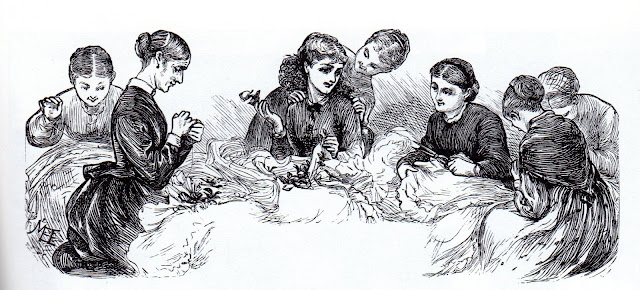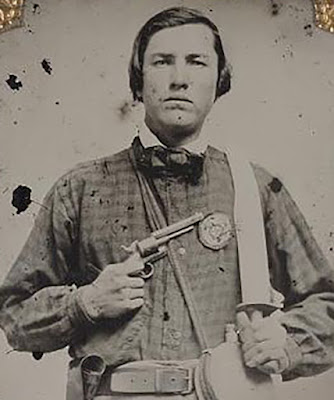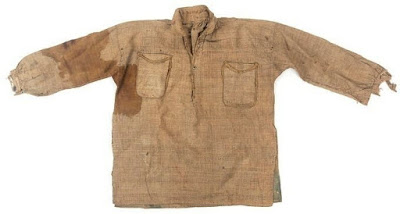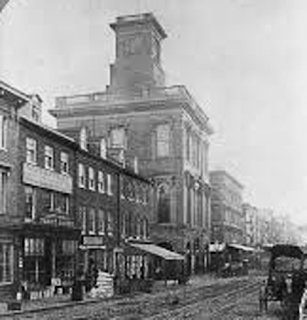During the flurry of personal narratives nostalgic for the defeated Confederacy's "Lost Cause" Myrta Lockett Avary published books and periodical features telling Southern tales of the Civil War, most notably co-editing Mary Chesnut's Diary from Dixie.
In 1903 she published a A Virginia Girl in the Civil War, 1861-1865: Being a Record of the Actual Experiences of the Wife of a Confederate Officer, telling readers that although names had been changed the experiences were accurate.
"Nell Duncan Gray" was an Atlanta neighbor, about 18 when the war began, just married to "Dan Gray" and living in Petersburg, Virginia. Nell recalled the first months of preparing the soldiers for army life, eagerly joining the other Petersburg women despite her all-too-common lack of skill in plain sewing.
"Before the war was over I had learned to make clothes out of next to nothing, but...except for fancy work, I had never sewed a stitch in my life. I could embroider anything from an altar cloth to an initial in the corner of a handkerchief, but to make a flannel shirt was beyond my comprehension.
"The bells of all the churches had become familiar signals calling us to labor as sacred as worship. Sewing machines had been carried into the churches, and the sacred buildings had become depots for bolts of cloth, linen, and flannel. Nothing could be heard in them for days but the click of machines, the tearing of cloth, the ceaseless murmur of voices questioning, and voices directing the work. Old and young were busy. Some were tearing flannel into lengths for shirts...."
"Make it, however, I could and would... I was determined that nobody but me should make his army shirts - I must sew them with my own fingers. I went down town and bought the finest, softest flannel I could find. Then I was at my wits' ends. I looked at the flannel and I looked at the scissors. Time was flying. I picked up my flannel and ran to consult my neighbor, Mrs. Cuthbert. She showed me how to cut and fashion my shirts, and I made them beautifully, feather-stitching all the seams."
As the war dragged on and cloth of any kind became hard to find Nell and her sister crossed into Union Baltimore to visit her mother and, as she told a soldier (no better at lying than plain sewing), "to buy a few things - needles, pins, and so forth." She also intended to buy wool for a proper uniform for Dan.
She was directed to a tailor with Confederate sympathies at the corner of Charles & St. Paul's Streets. "He showed me several pieces of very fine and beautiful cloth of Confederate gray, and I made my selection...."
But how to smuggle good gray wool back across the Union lines? The tailor had experience:" 'I will cut this cloth into lengths that will be all right for the tailor who makes the uniform. You and your mother can make it into two Balmoral skirts. That's the way you get your cloth home.' "
"The tailor changed the buttons on our cloaks for Confederate brass buttons covered with wadding, and then with cloth like the wrap....We wanted to take Dan some flannel shirts, and again fashion favored us. Ladies wore wide plaid scarfs passed around their necks and falling in long ends in front. We got seven yards of fine soft flannel in a stylish plaid and cut it in two lengths. Mother, being quite tall, could wear a longer scarf than myself, so, between us, we managed to carry around our necks two good shirts for Dan."
Who was Nell? She left a lot of clues. She was a member of Petersburg's St. Joseph Parish, headed by Father Thomas Mulvey. Catholics have certain naming patterns---I'd be looking for a saint's first name.
Her husband was an officer in the cavalry headed by General Rooney (W. H. F.) Lee, the 9th Virginia.
The anonymous couple is probably Margaret Herron Bowden Nash (1844-1902) and Joseph Van Holt Nash (1834-1900), above in the post-war census in Petersburg where Joseph was a merchant and they have two children and four live-in employees. Joseph had attended the University of Virginia and was a Major serving as Adjutant General to Rooney Lee and later to General John Chambliss. They eventually had five children.
Both Myrta and Margaret lived in Atlanta at the end of the 19th century. Margaret died in 1902 the year before Myrta published her story.
Margaret's Find-A-Grave file: https://www.findagrave.com/memorial/23522931/margaret-herron-nash
A Virginia Girl in the Civil War, 1861-1865: Read Mollie Bowden Nash's memories (Nell Duncan Gray) here:















2 comments:
My great grandfather was a tailor at Charles and Pleasant Streets in Baltimore, but not until the late 1880s, at the earliest. He wouldn't have been old enough to be there during the Civil War and may not have been in the U.S. then.
But interesting to hear about tailors with political allegiances. My grandfather was a garment cutter in a New York factory about 1910. An immigrant too.
Post a Comment